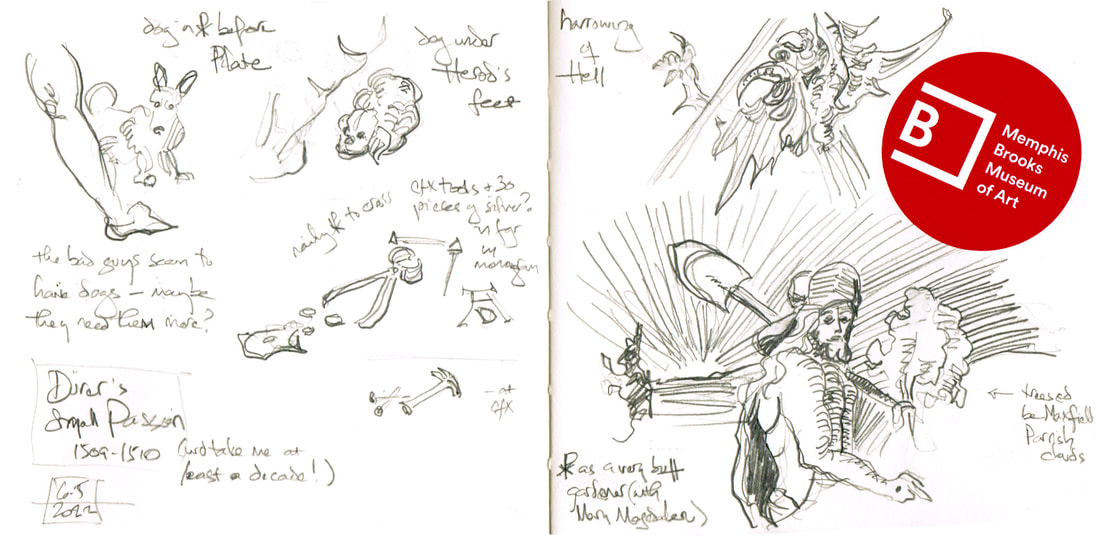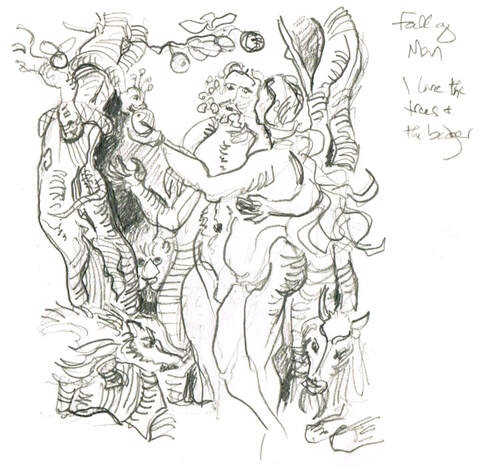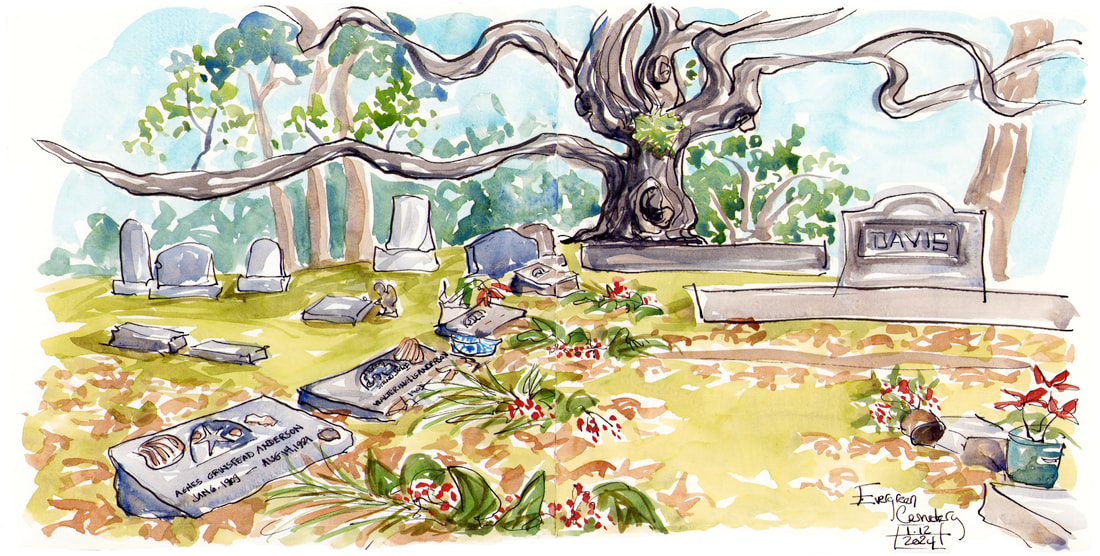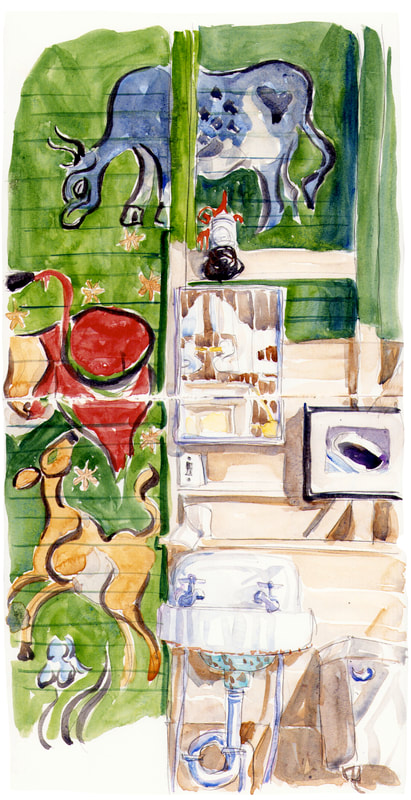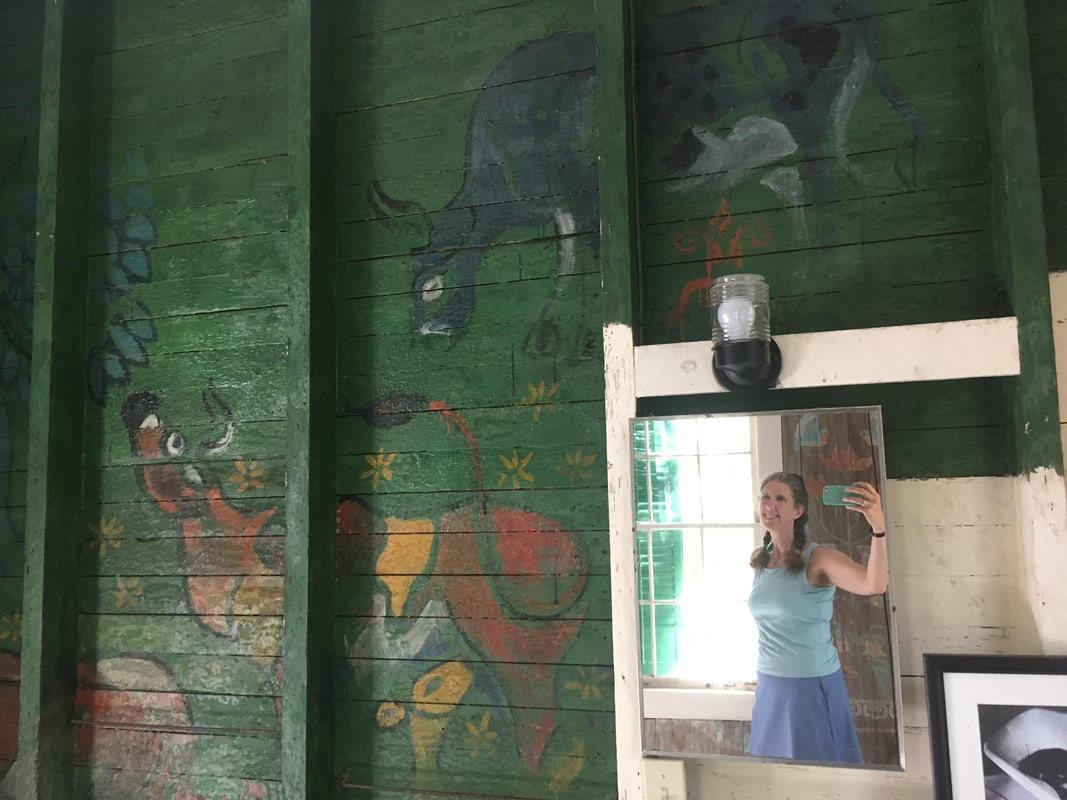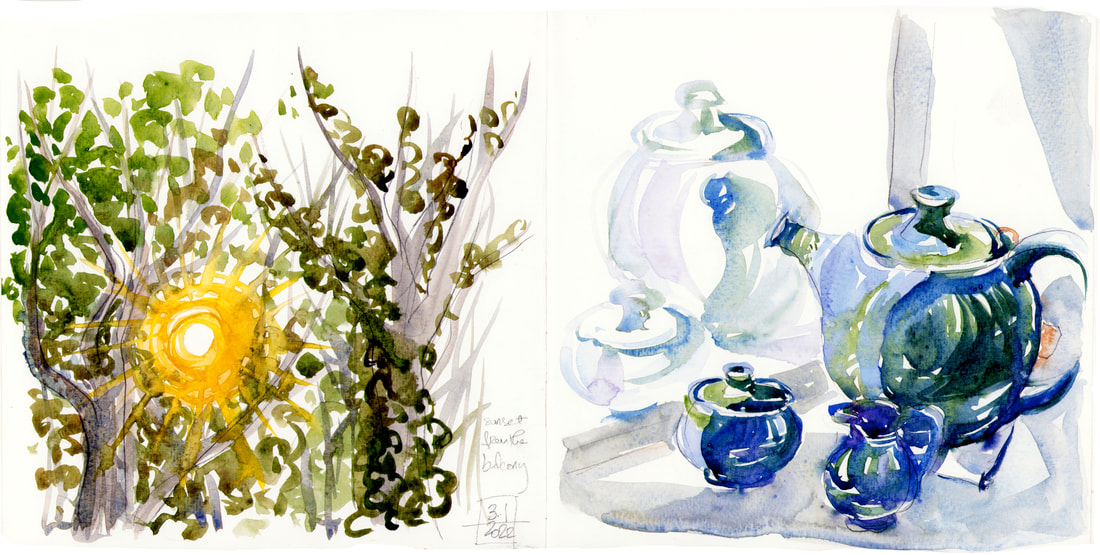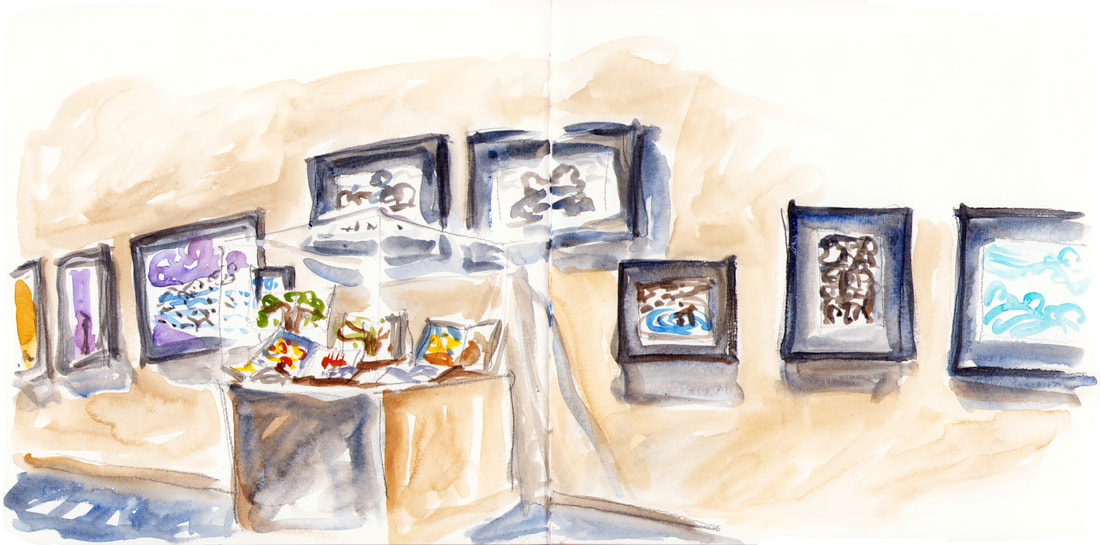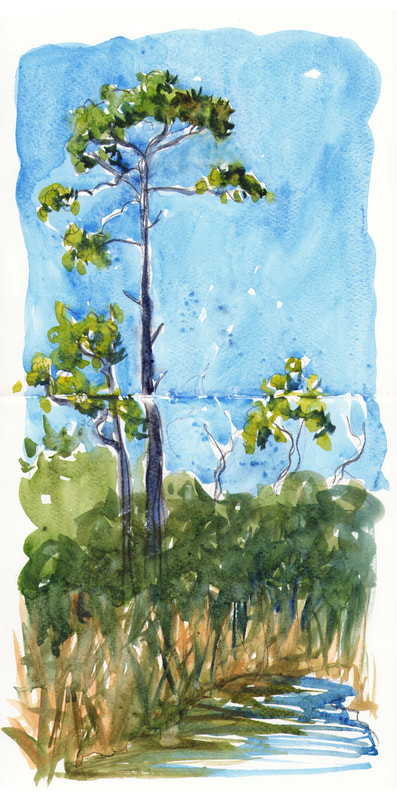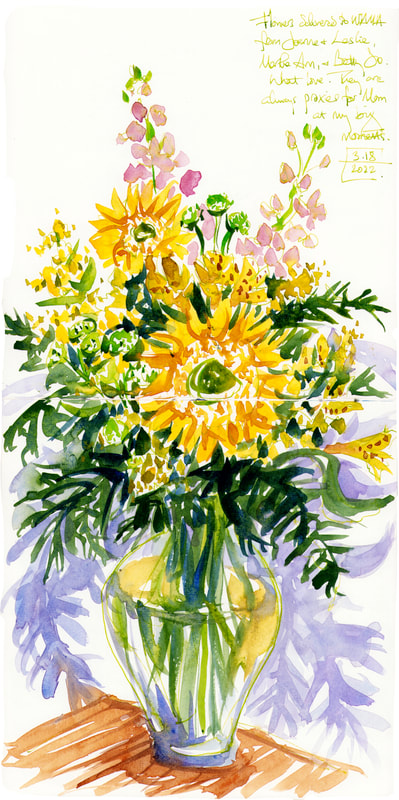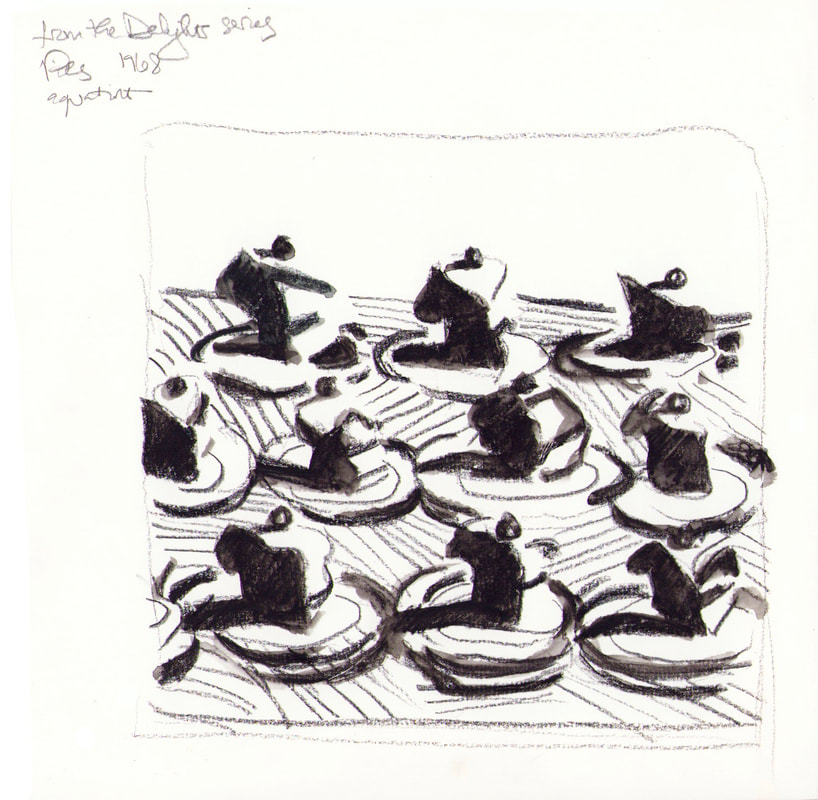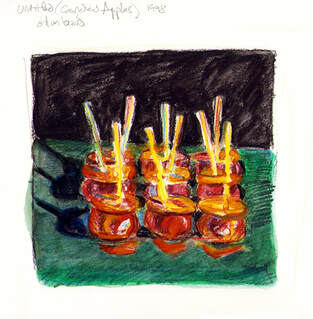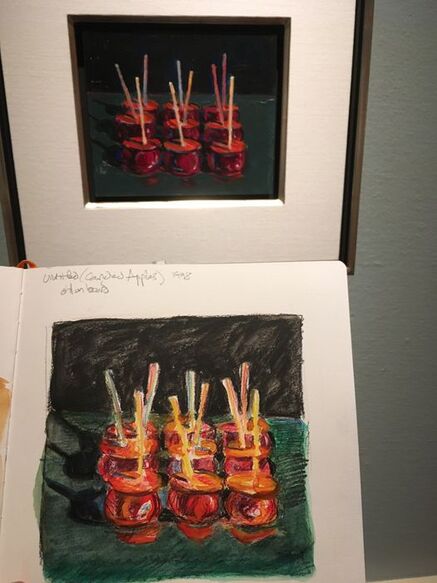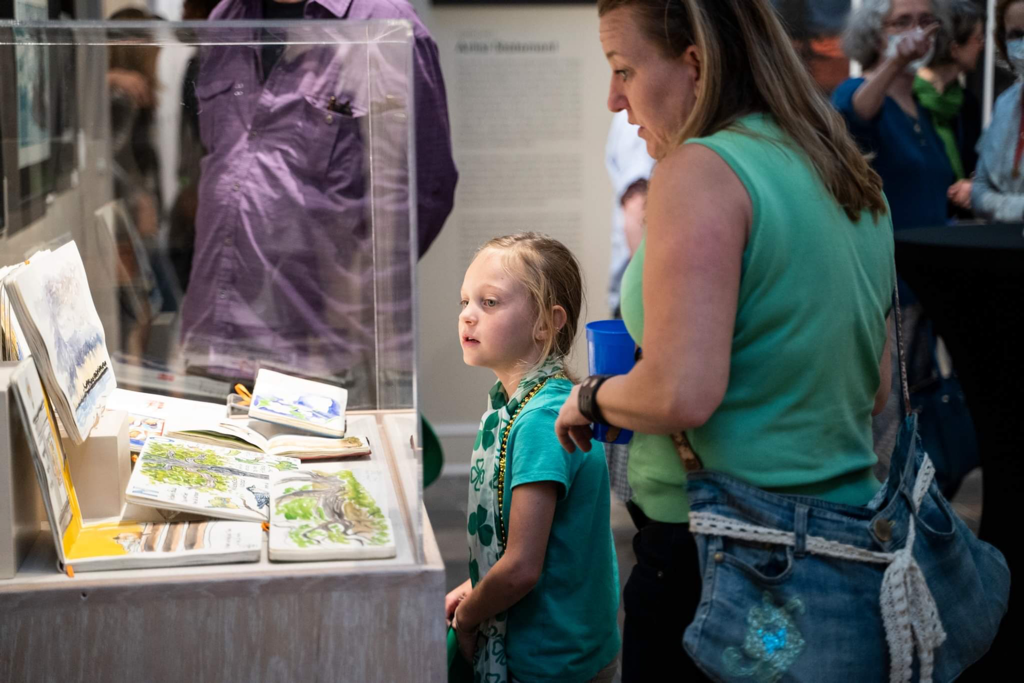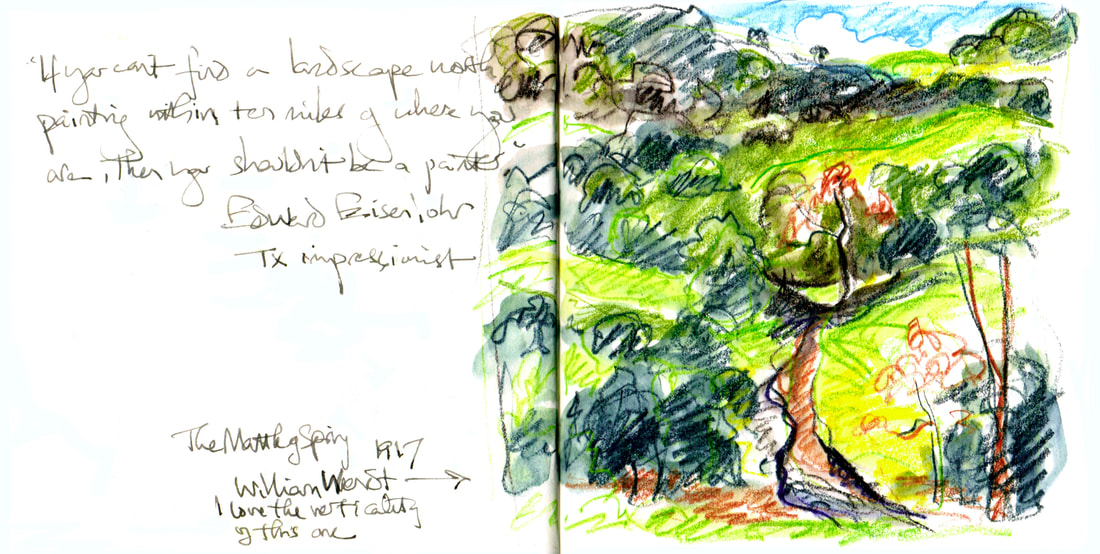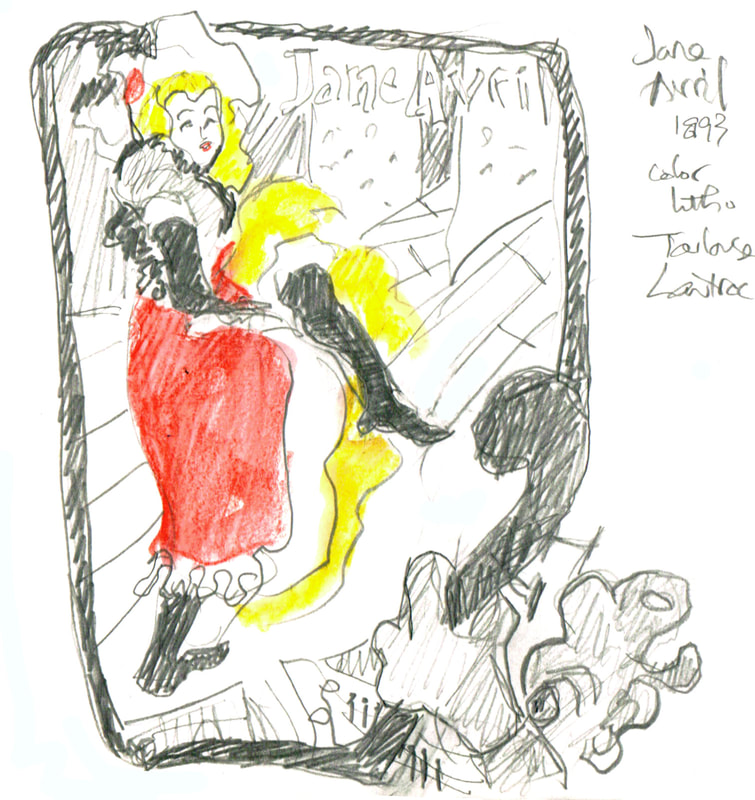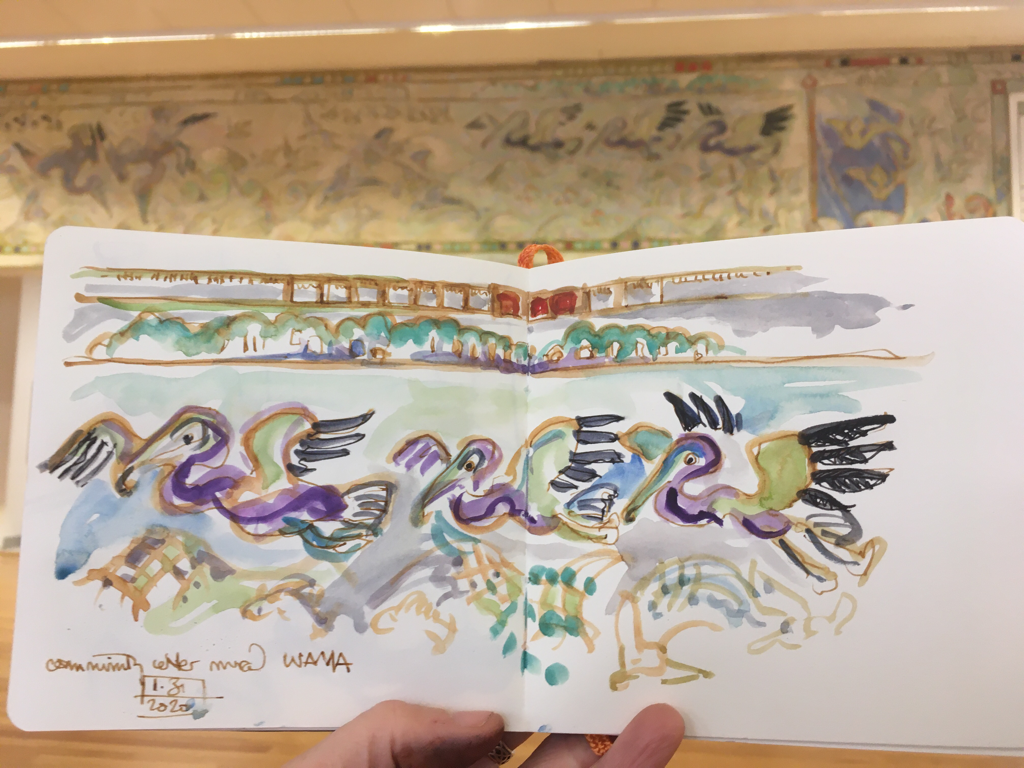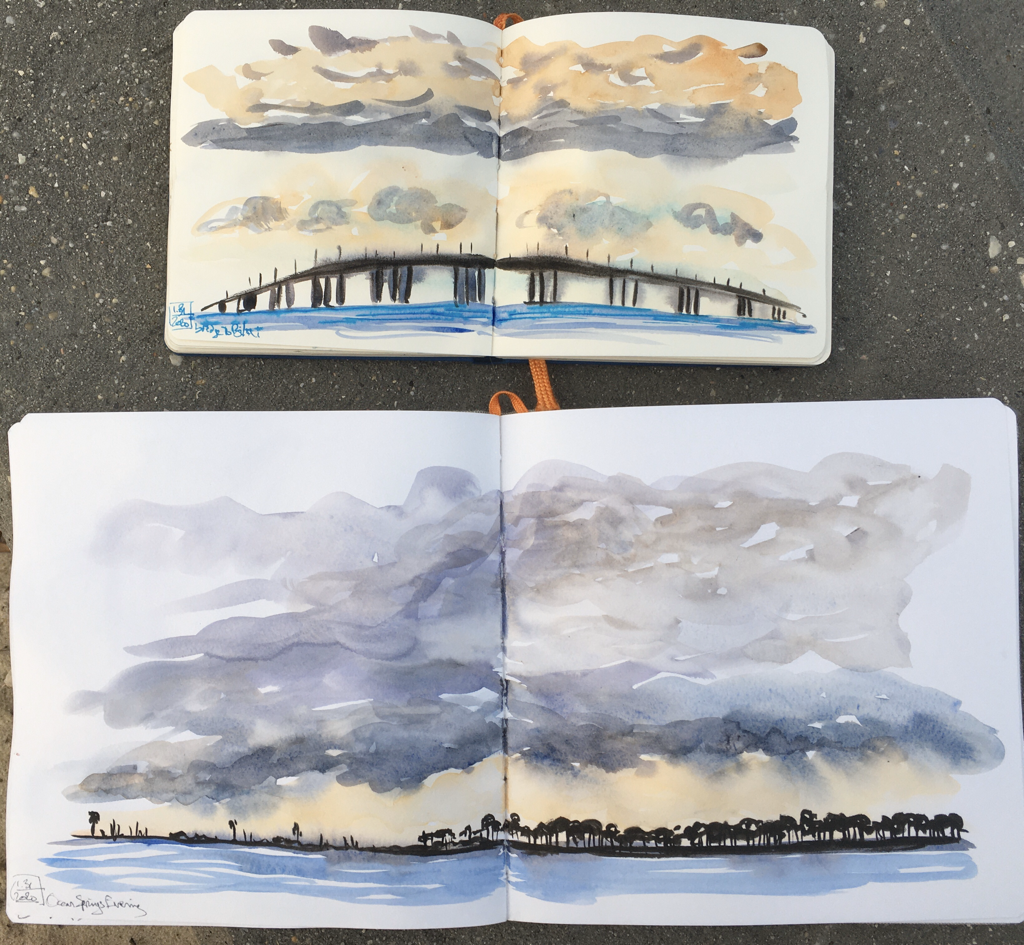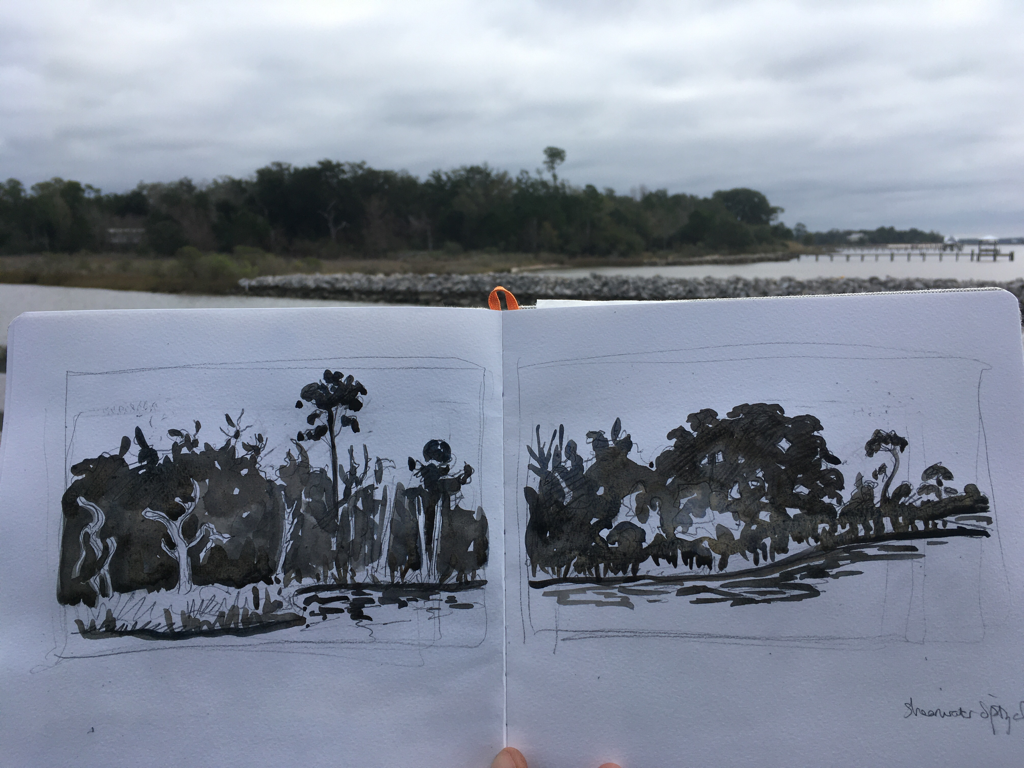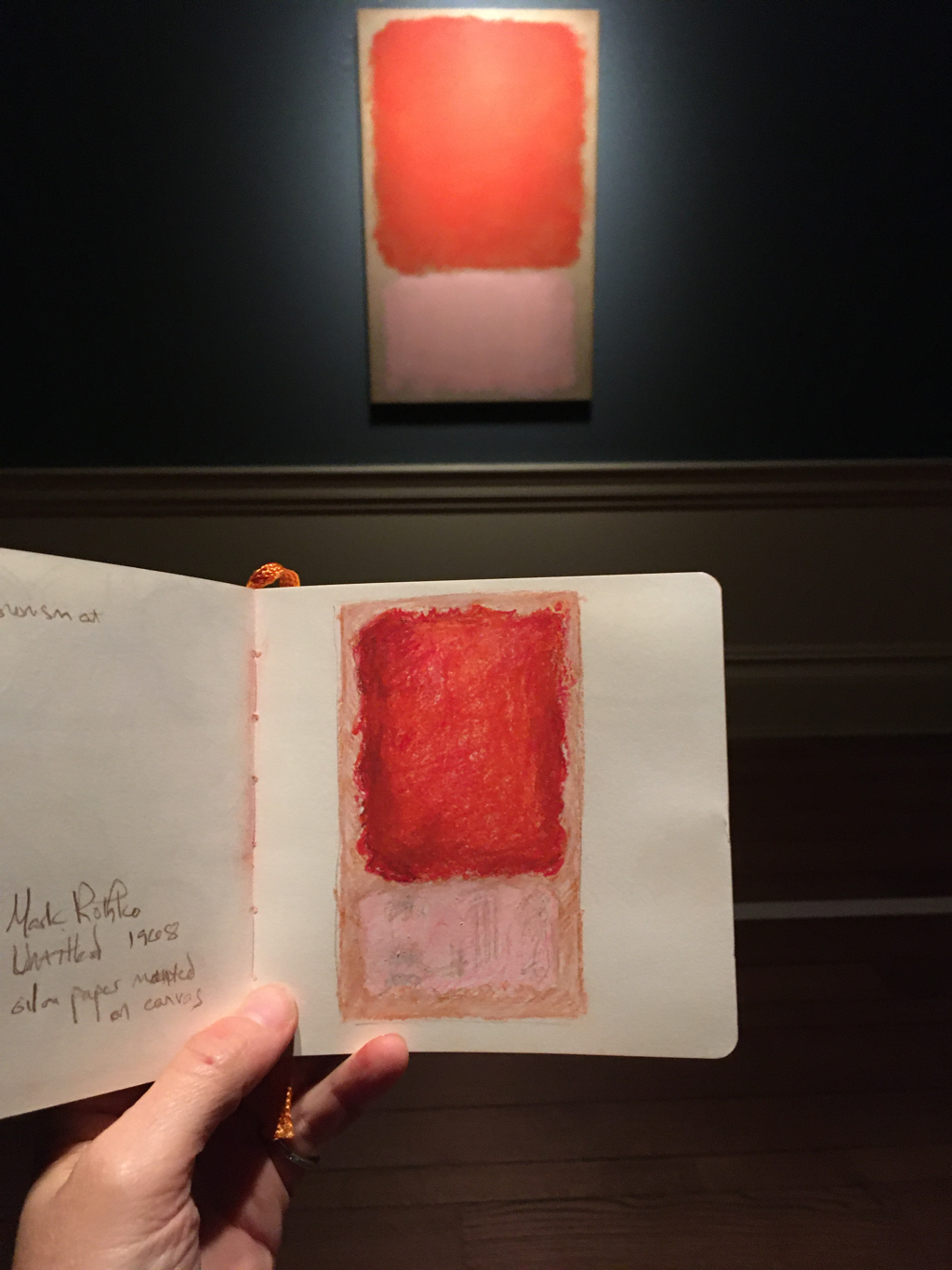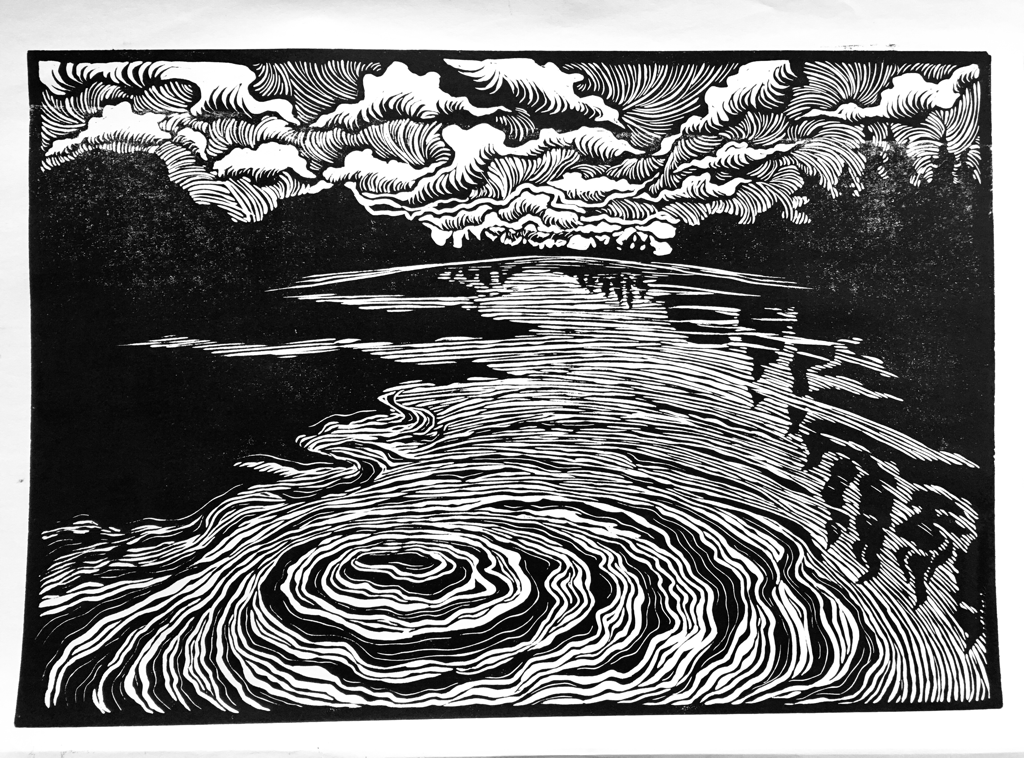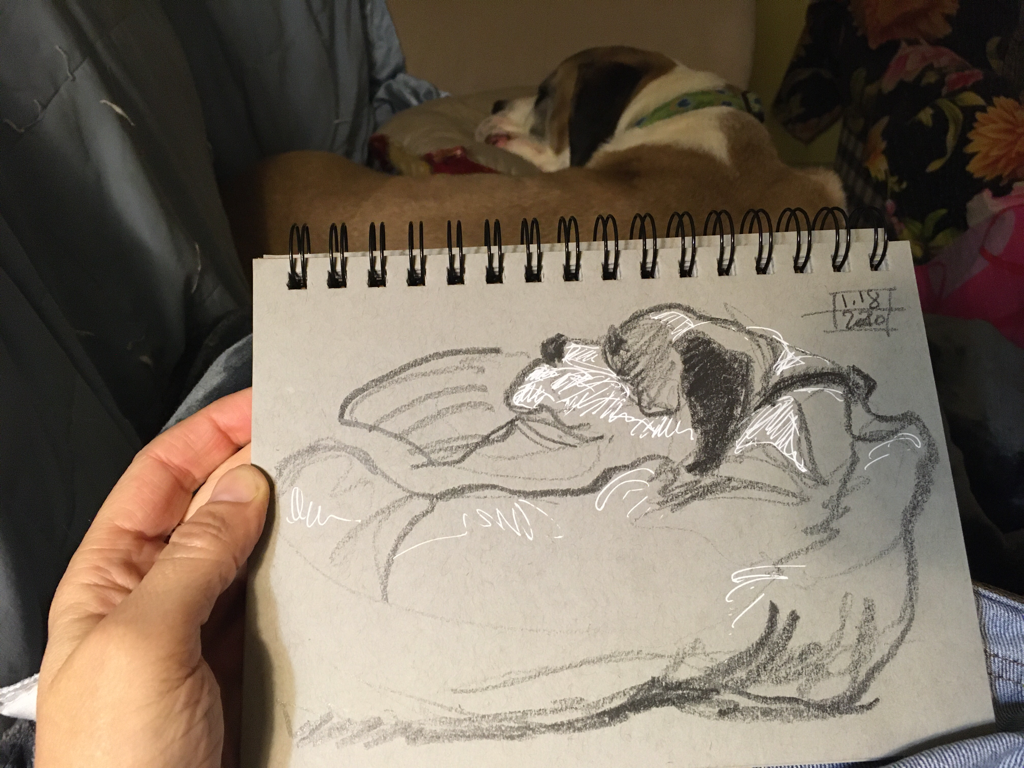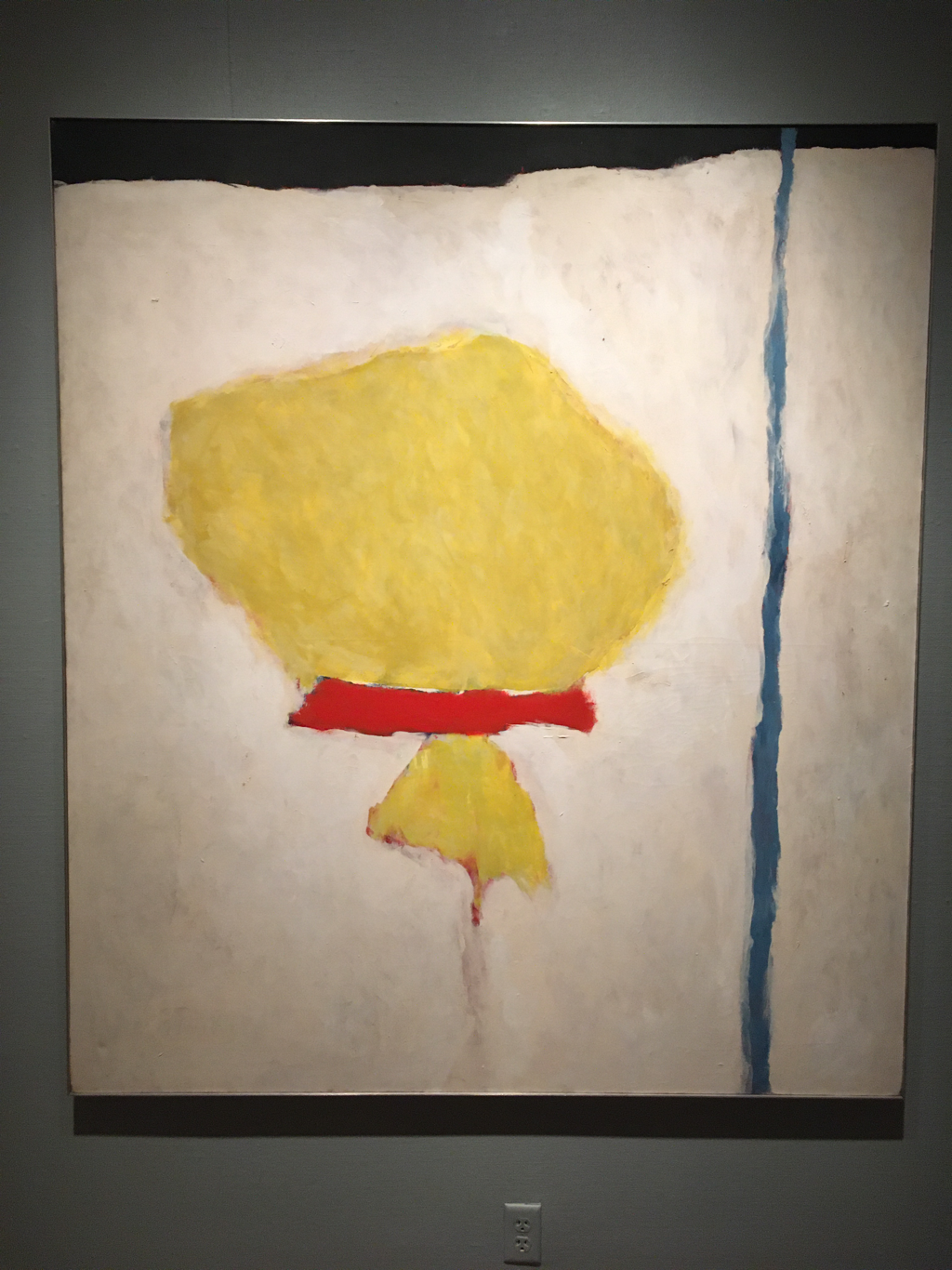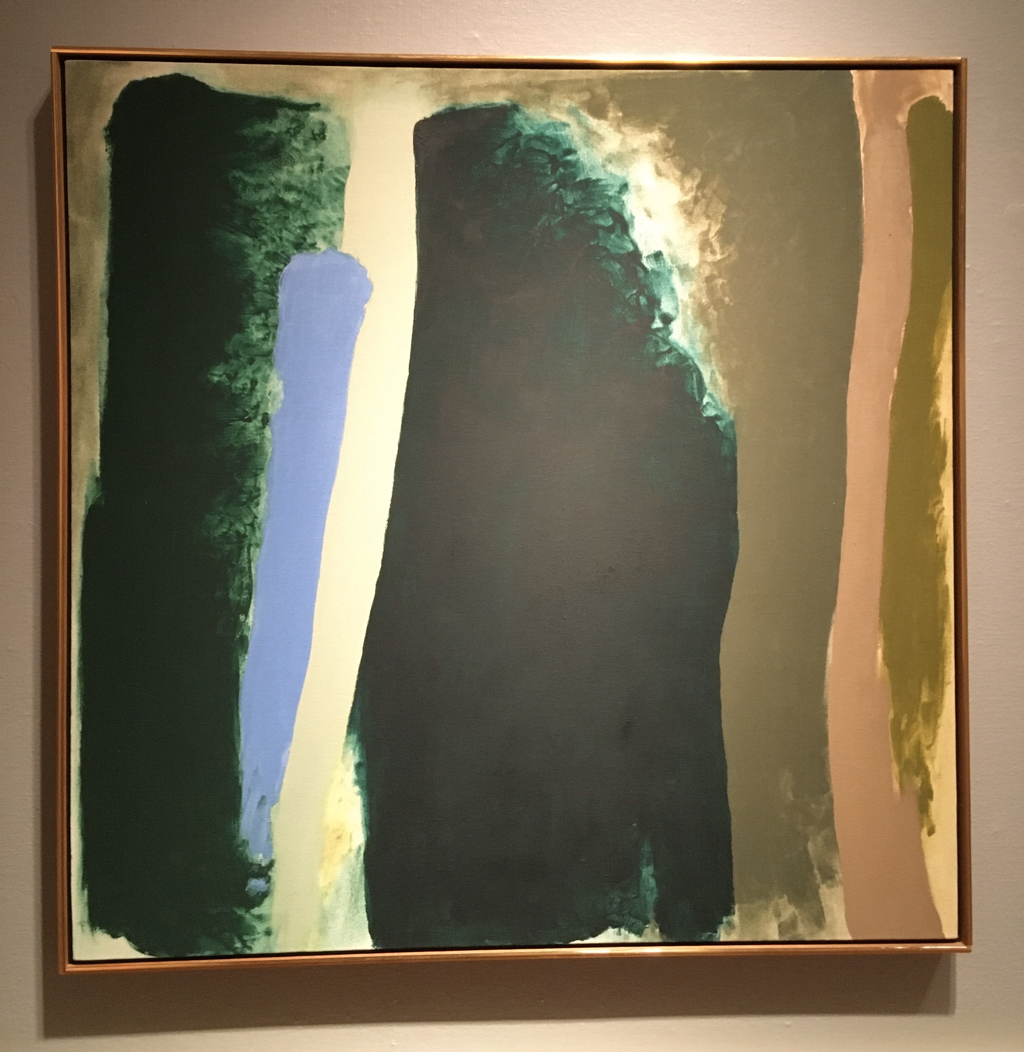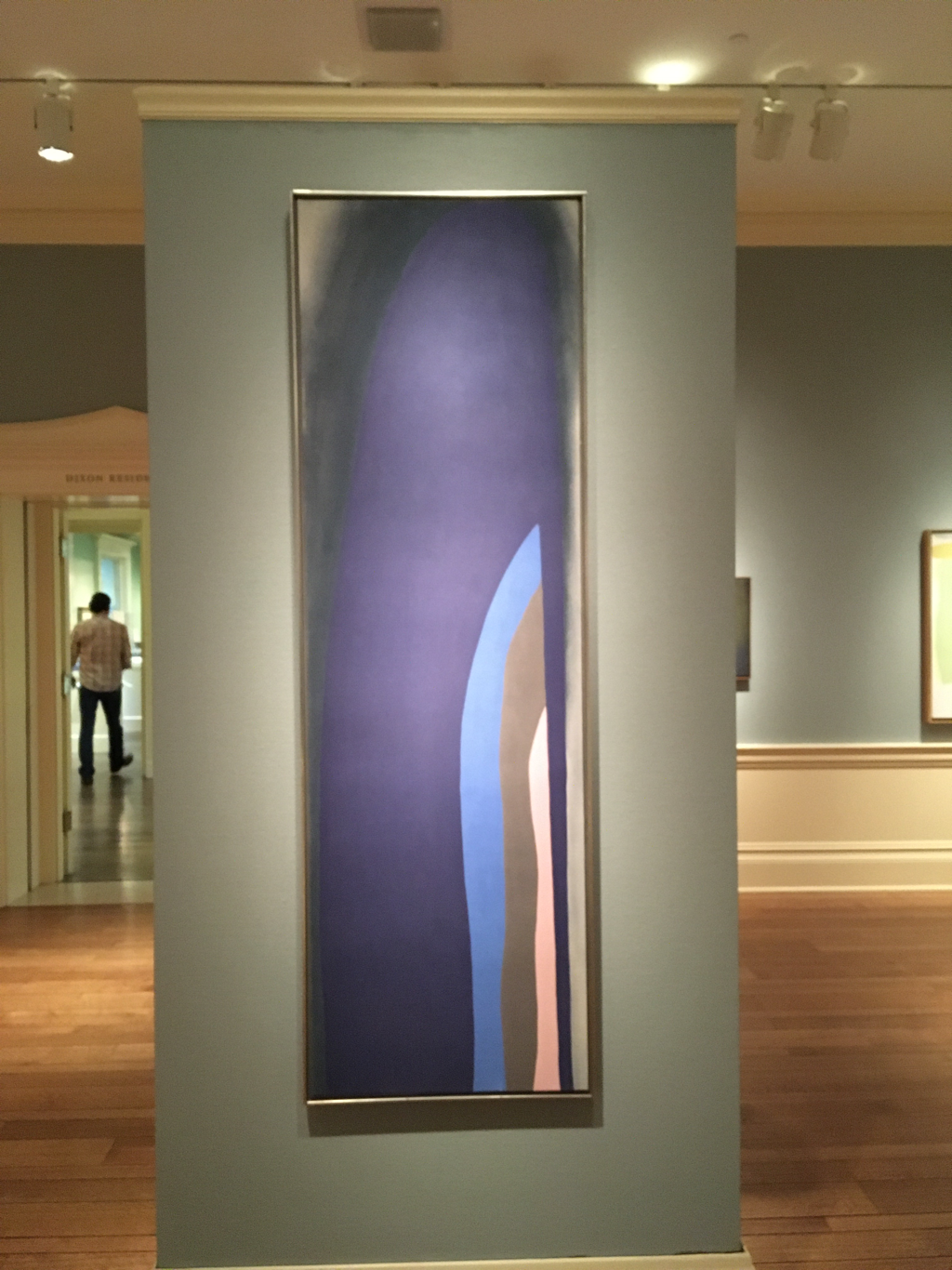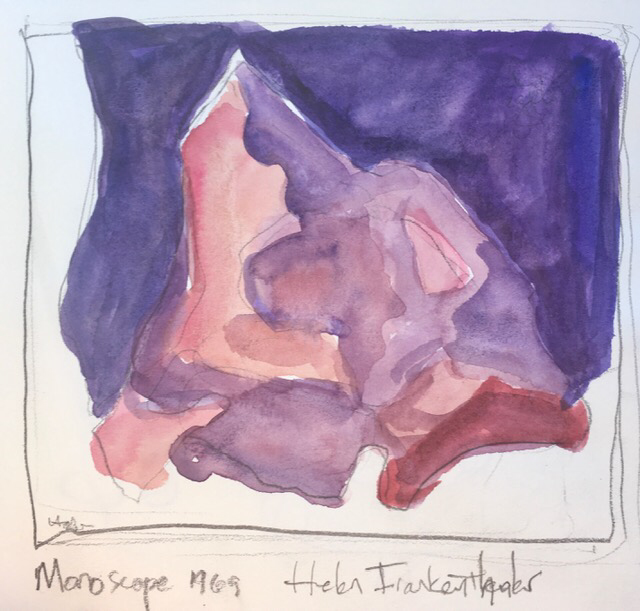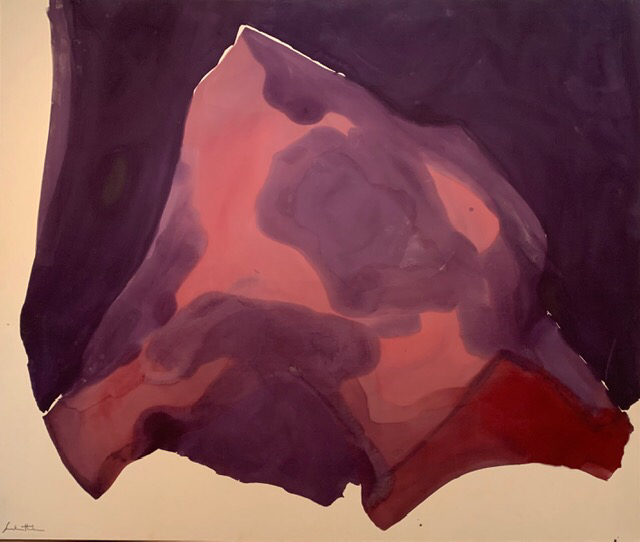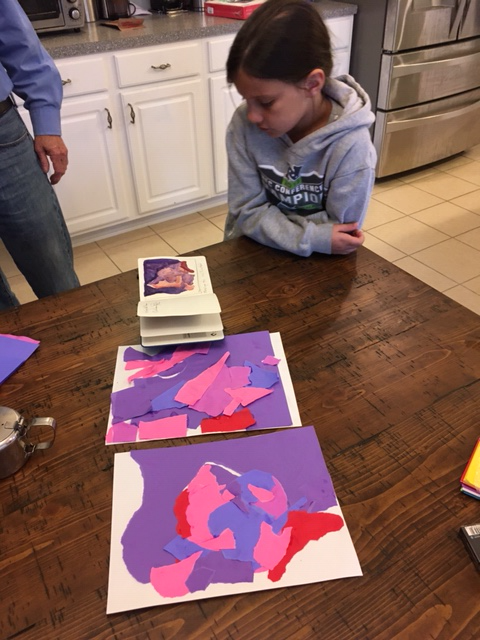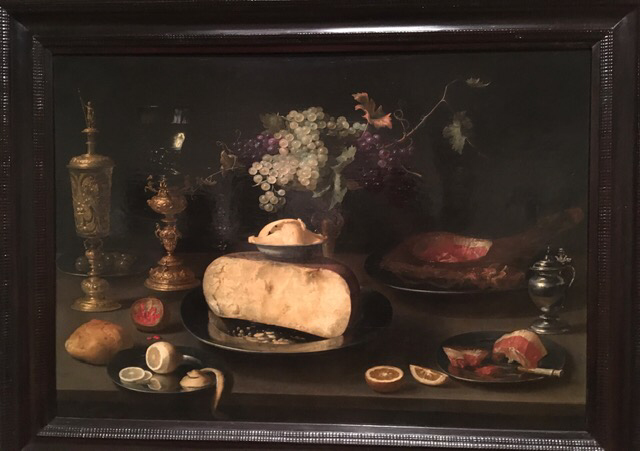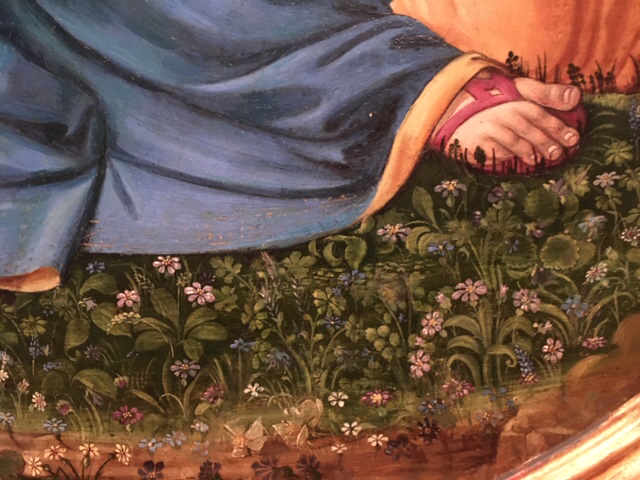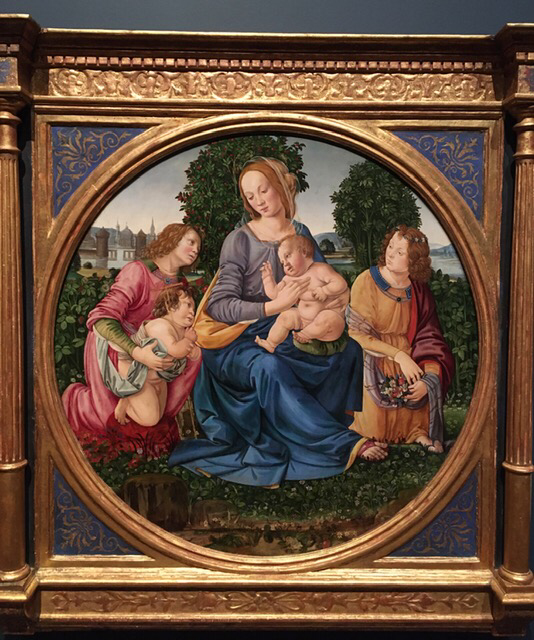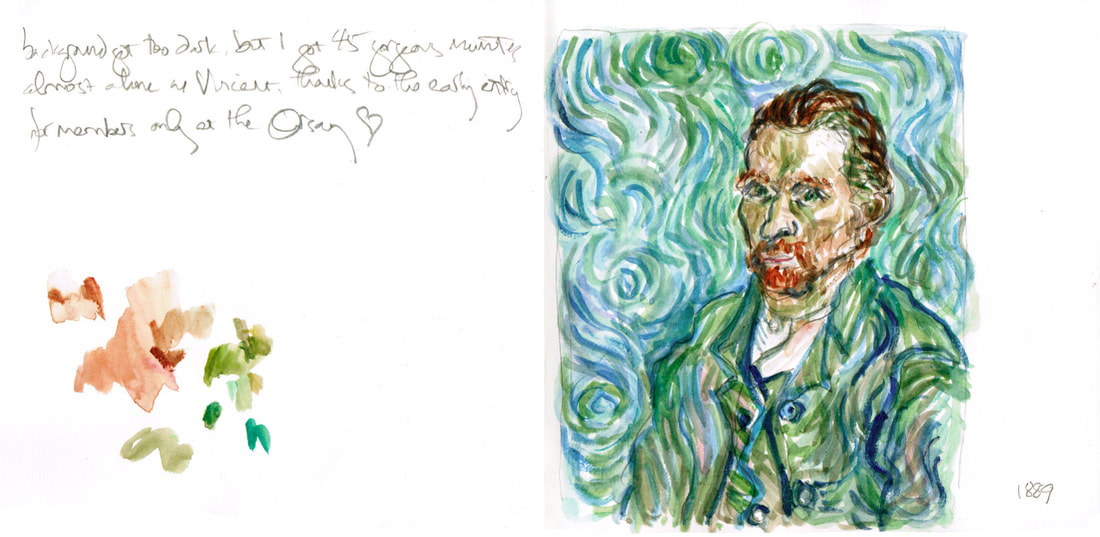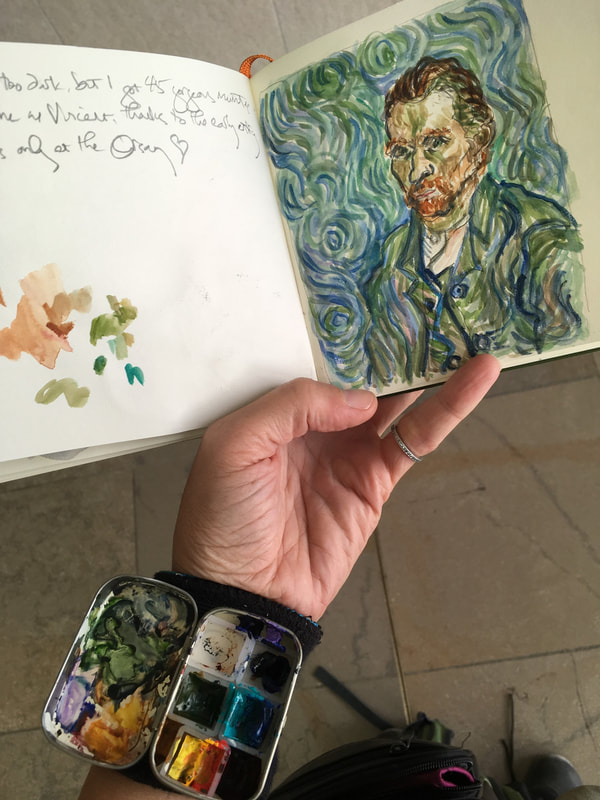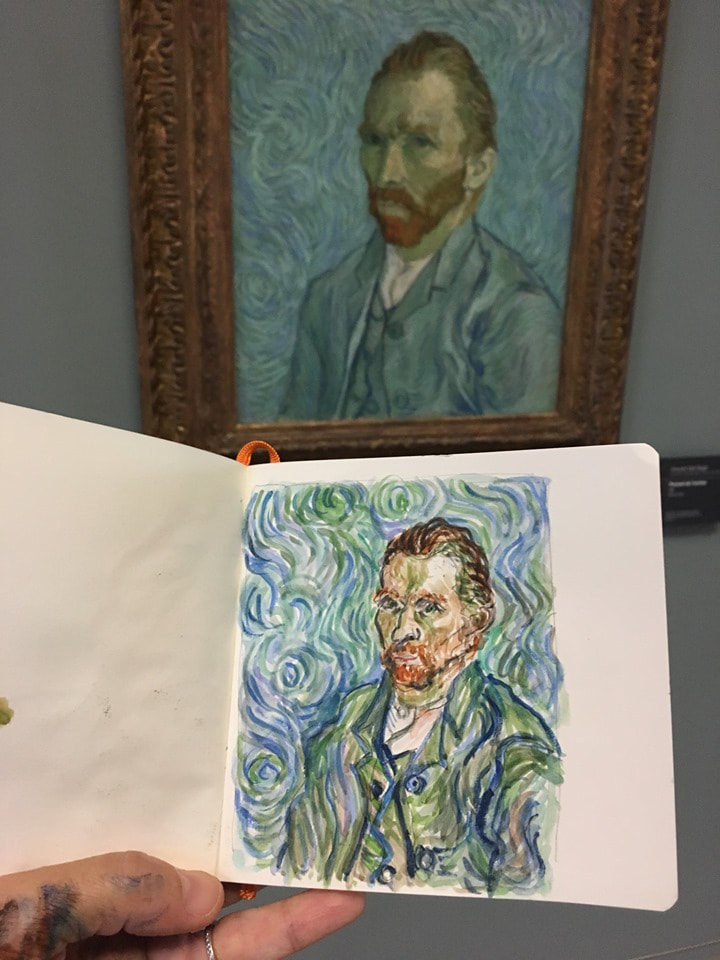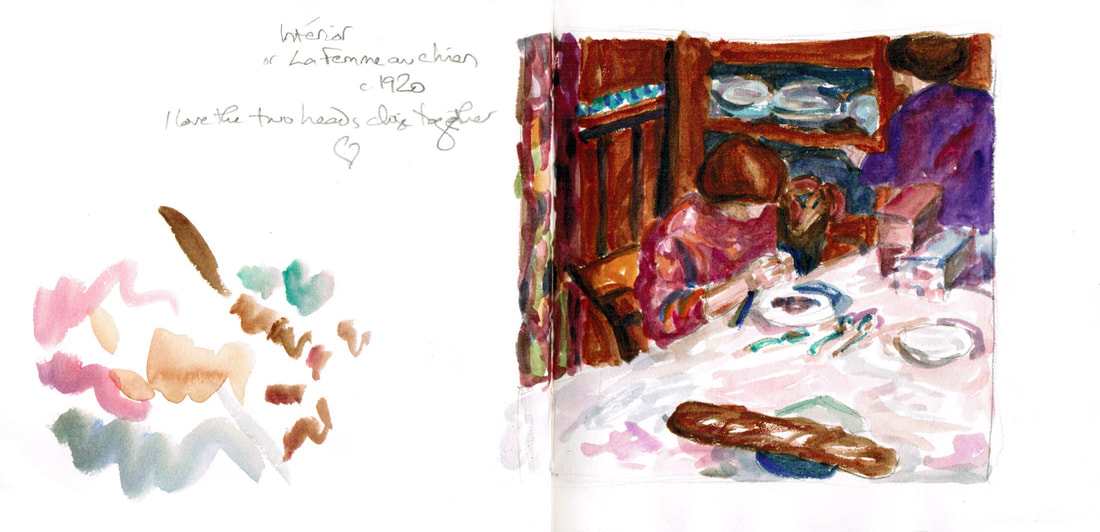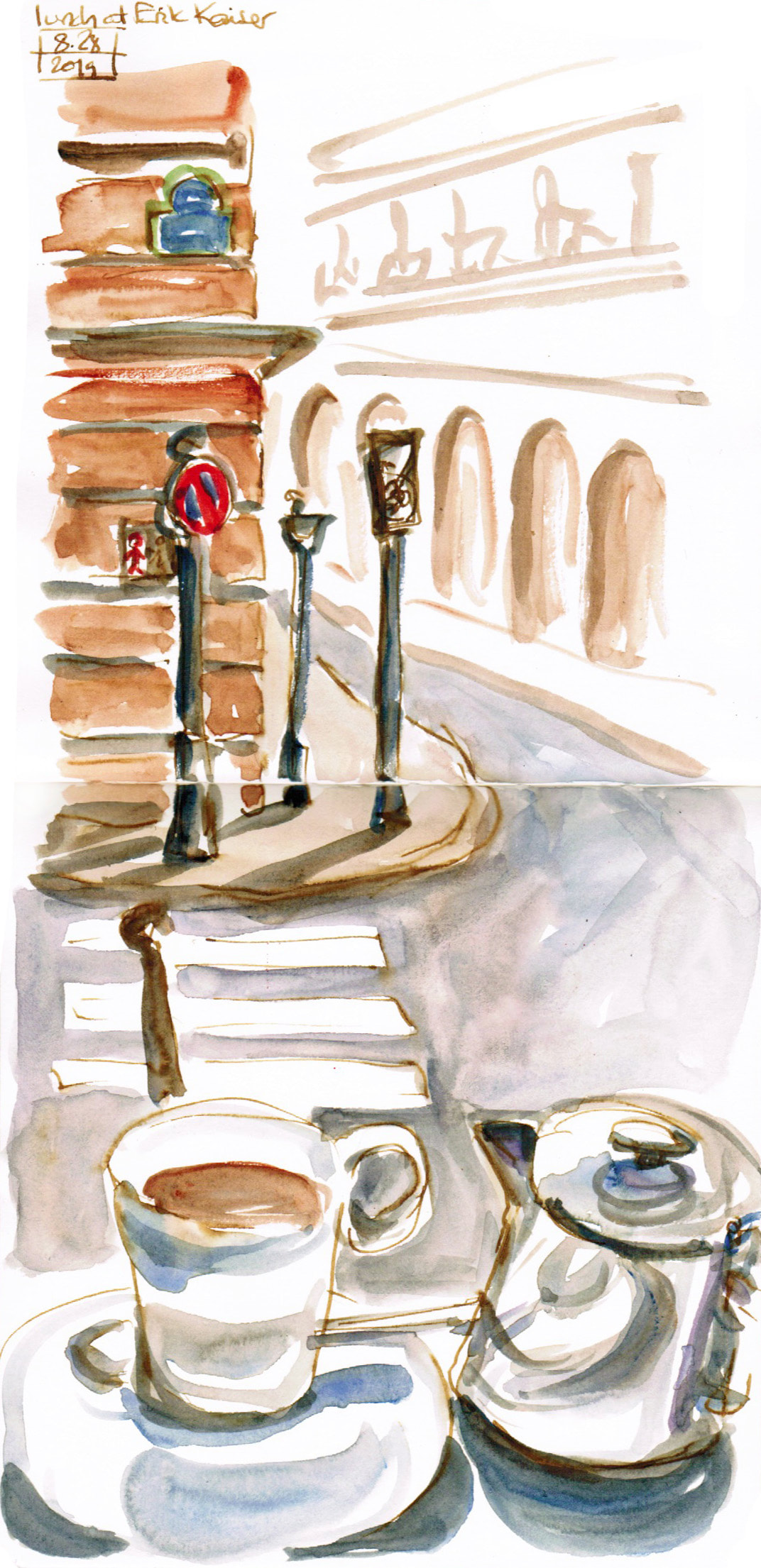|
There have been some awesome printmaking exhibits around recently. Brooks in Memphis put out their full complement of Durer's Small Passion, which is detailed and delightful. They can only show it every so often since it is fragile and on paper. I think the equation is something like "for every three months it's on show, it has to rest three years" or something like that. I didn't get over as often as I had optimistically planned to, but I did make it several times and spent some quality time sketching in the end. His use of line, like with all wood engraving, is what makes the print. But I was also fascinated by the details -- crucifixion tools lying at the foot of the cross, his signature not flat with the picture plane but in perspective (though he did get his D backwards a couple of times, which thrilled me to see --- even the top drawer printmakers can screw up the backwards bit sometimes!) I loved the trees and the animals. Several pieces had small dogs in the foreground. I did notice it was the villains of the piece who mostly had dogs (Pilate, Herod, Caiaphus), but I wonder if they simply need the ministrations of dog angels more than the rest of the cast did. I also loved Jesus in his floppy gardening hat with a spade over his shoulder (but the stigmata noticeable). Most of all I loved the Adam and Eve in the garden underneath trees that have a through line down to E.H. Shepherd and with a badger (!) among the animals gathered around. I drew the tree carefully and the figures a bit less so, but I loved spending deep time looking at this one. Walking home, a tree reached out to me and called to be drawn, so I worked on using the character of Durer's lines to describe it (even if far less small and precise). 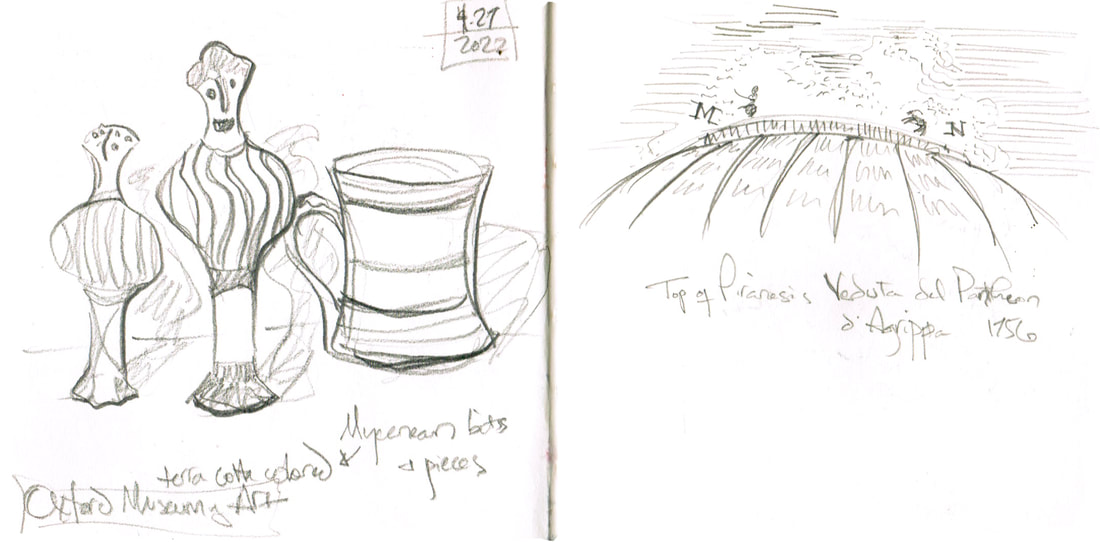 A second remarkable show is a set of Piranesi etchings at the University of Mississippi art museum. These are in their collection as well. None of the fantasy dungeons, sadly, but still some pretty delightful and whimsical details, like the figures up on the top of this dome with letters floating beside it. The letters, I realized later, corresponded to a list of building parts at the bottom of the print, but even so, their slightly wonky air felt whimsical as well. I also sketched a few decidedly whimsical (that was the word of the day) Mycenean pottery figures. I loved their stripes and happy expressions. I wish local museums would let us work in more than graphite, but the pencil did suit the engravings I was working from, and it felt good to do master copies again, even if only bits and pieces that appealed to me.
0 Comments
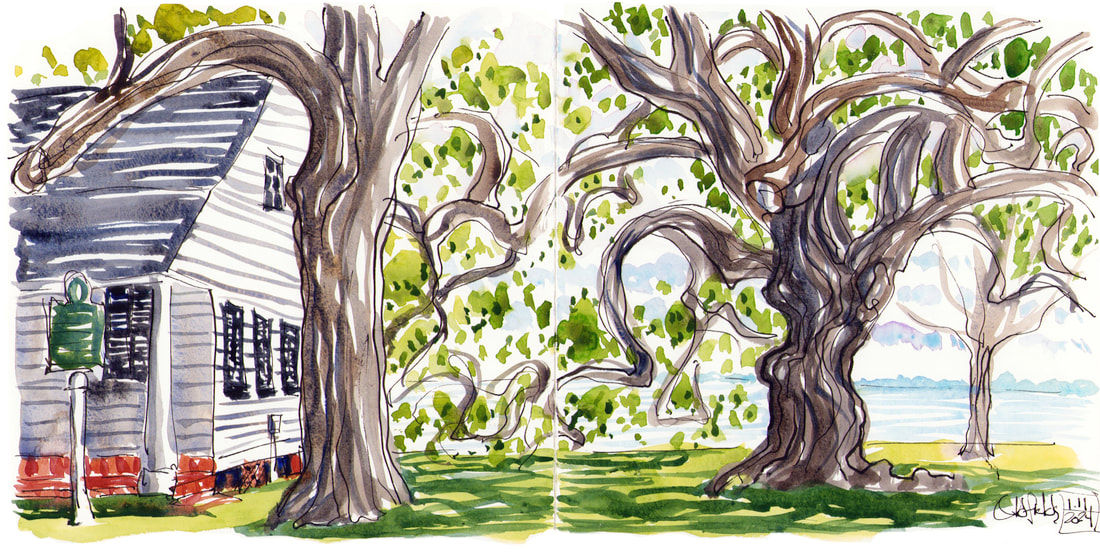 I finally got my sketches from Anderson's cottage scanned in to show better than an iphone snapshot can. It's a miracle of a place. This top one is the wall of windows that flashed me back to Monet's first studio at Giverny -- that same porous sense of indoor and outdoors flowing together because of height and light and windows. Anderson built the window seats and cabinets, and the carved chair is a replica of his made by one of the talented family that still lives at and around Shearwater making art and keeping the legacy of all three brothers (and their mother, who first dreamed of an artist colony) alive. Below are two from the bathroom. I loved his bathtub murals. Anderson had been cycling through Texas, and he would strip and bathe in ponds as he encountered them. At one pond, a group of cows came up to gently see what was happening in their accustomed watering hole. It was a magic moment for Anderson. He made a series of paintings about it, and he missed the cows when he got home to his own bathtub. His solution, genius and beautiful, was to paint them around his own bathtub so he could always remember and have their company. I celebrated delivering my new show by sketching lots and also buying a new "I HAD A SHOW AT WAMA" tea set that will forever hold these happy memories for me. I had gone to Shearwater Pottery just looking for a cream pitcher, since I'd recently broken one of my favorites. But of course I ended up with a teapot too. Actually not "of course" -- teapots are hard to make, and they don't always have them in stock. This blue/green/grey glaze was so gorgeous I couldn't resist. In an added bonus, when I got it home, I found that my new favorite tea infuser fits EXACTLY into the hole with the lid going just inside it, so it's my easiest to use teapot of all the ones I now have. (Lots of them, sadly, are too narrow for my infuser, so I use them less than I used to, but I do still rotate through them for joy.). Speaking of joy, they got my show up on the walls before I left, so I sat in the gallery and did a celebratory sketch of it. So much joy. I also sketched this tall tree that I've been wanting to do a print of. It's good to have sketches as well as just photos to work from, though both are helpful in different ways, especially for more detailed subjects. And I'm adding in a second vertical that I did at my opening weekend to balance it out. My mom's three best friends have shown up for me at all the truly important passages of my life, acting as her proxies. They couldn't be at the museum in person, but they sent these gorgeous flowers to mark the occasion, and I couldn't be more grateful.
I went back to do some more sketching in the Thiebaud exhibit. I love the lines and almost abstract shapes of the black and white aquatint. And I love that he did a whole series called "Delights." That kind of small, every day delight has been an intention focus for me during the pandemic, and it's lovely to be seeing his take so beautifully and in person.
My second piece of the candy apples couldn't at all capture the richness of the painting, since I was working with a limited set of colored pencils. The Inktense pencils do have a lot more richness and saturation than the regular watercolor kind, but they, like any others, are pretty limited to the hues they give you. It's much easier to mix colors in paint instead. But looking at any painting long enough to sketch it really teaches you a lot, even if the sketch is (never, really) what you hope it might be. I had a ball, though. And I love taking that kind of immersive time with great paintings. I have an insane amount of stuff to do this week, but I celebrated finishing my last commission by stopping at Dixon on my way home to see the American Impressionists exhibition one more time before it closes. I also wanted to sketch this lovely Boudin from our permanent collection. It’s not always on view, and I love having it out. I’m way out of practice for this and didn’t leave enough room on the left (I always get larger as I go), and pencil is not my best medium, but it was so good to spend some time looking deeply at this one. I’m celebrating vaccines by making time for some important things I haven’t been able to do lately. Like getting a couple of waltzes and a good visit with my sister yesterday. Means so much. I have missed dancing for that jolt of joy in my life. Art is deeply satisfying and necessary and how I interact with almost all the world, but dancing is JOY. I’m so grateful to be easing back with a vaccinated partner or two even if it will be a while before we fill a gym with sweaty, smiling people.
I hit the point of full vaccination last week and have been doing a few cautious things the last few days. I've been wanting all spring to go to Dixon and see the American Impressionism show there, so Tuesday morning I went right as they opened and had the exhibition to myself. It was gorgeous and thought provoking and interesting, and I got a lovely chat with Kevin Sharp who saw me there and talked about the Prendergast piece and also Euphemia Fortune's chickens. They were one of my favorites, and he said he loved that she lived just near the big, craggy ocean shore but chose to paint daily life, and beautifully. I loved that too. Although I hated that she felt she had to disguise her name and go by a first initial to be able to exhibit.
There was a bench by the William Wendt (sadly not by the chicken piece, though I may still go back), and I loved the upright composition of this one, with the brown creek at the center falling out from underneath the viewer. I loved the tiny line of sky at the top and the dark masses of trees. I had taken my Inktense pencils (my watercolor brush pen, fine in Europe, is not allowed in the local museums), and I drew very quickly in the almost dark. The painting is lovely, and the sketch is chicken scratch, but it reminds me of the composition, and spending enough time looking at a painting to draw it is always a good exercise. I also wrote down the quote from fellow Texas painter Edward Eisnlohr: "If you can't find a landscape worth painting within ten miles of where you are, then you shouldn't be a painter." This reminded me strongly of John Constable and Walter Anderson and all my art heroes who painted their own places instead of rushing off for the grand and fashionable scenery of the day. The next day I went to Brooks to see the French posters exhibition, which I also had to myself for the first hour. They have enormous Mucha, Steinlen, and Toulouse-Lautrec lithographs. Fantastic. I love Mucha for detail and fun, but I must admit that the Toulouse-Lautrec ones had the most arresting compositions. I sketched this one, partly for the wonderful design, and partly for the bass player at the bottom. It's been wonderful just to stand in the presence of art again. I have missed that so very much this last year. And I love sketching from it as well. I learn so much every time. Part of my sister’s wedding festivities were in New Orleans, and I just couldn’t get that close without heading to Ocean Springs and the Walter Anderson Museum of Art. I’m a homing pigeon for that place. It was a good choice. I stopped at my favorite antique mall on the way down, spent a lot of the afternoon in the museum, swung through Shearwater Pottery, and was out on the pier for sunset. I forget how elemental water is. I spent at least half an hour just standing and drinking in the sunset, the pelicans skimming right along the surface of the water, and the moon and clouds playing peek-a-boo overhead. I think I grinned ear to ear the whole time. It was a stunning evening. I did a couple of golden hour sketches before enjoying the sunset, one more successful than the other, but sunsets are dicey that way. The next morning I took my walk by the water and spotted a row of trees looking across the water to Shearwater from the marina (the complex where Anderson’s family lived), so I walked back for my sketchbook. It was cold, but I did a quickish grisaille study for a print — to get the shapes and the black and white. For those of you who haven’t had the joy of seeing pelicans lately, here is a small bit of joy for you. I’m home and happily working on the print I drew out now. I’ve never known that much about abstract painting, and I’m generally drawn to more figurative work, but I’ve been looking forward to getting enough space from show season and crazy family stuff to get over to Dixon to see this exhibition. It’s a stunning one. I’ve been twice this week and could even be tempted to go back another time before it closes on Sunday. Rothko is my absolute favorite of the abstract painters, but I had fallen deeply for a Helen Frankenthaler painting in Omaha a few months ago, and there’s a less totally stunning but still lovely one in this show. There’s also a gorgeous de Kooning, and I loved the second show of just Dzubas paintings (an artist I wasn’t previously familiar with) collected by a local businessman. It was a stunning retrospective of four decades of his work, and a number of them sang to me. I loved seeing the progression too. My only quibble with the main abstract show was that it was only one painting per artist. I really like being able to see two or three of the same artist, compare them together, get more of a feel for the body of work. Their survey of women artists earlier this year (with many less famous names — I was already somewhat familiar with a number of the abstract painters) was even more disorienting that way. I wanted to see more than just one. It’s almost jarring to move artists with every painting and have no compare and contrast ability. But that’s a small complaint about a stellar show overall.
I went back the second time with every colored pencil I own to try to capture a little of the texture of the Rothko, and the Stamos had also been calling my name. I did one small sketch of each. The de Kooning was too intricate for me to take on that day, and I didn’t have any of the right colors for the Dzubas pieces I liked best. With watercolors I can mix anything, but pencils just are what you have. The last two pieces are both by Dzubas. I visited family over the weekend and also did something of a Midwest art museum tour. Back in college I had taken one summer sculpture class in Omaha and visited the Joslyn, but my memory of it was hazy at best. It was a total delight. A gorgeous variegated pink stone building housing a beautifully curated collection. We had just that morning seen a piece on Helen Frankenthaler on one of the Sunday morning shows. My art knowledge of mid 20th century and beyond, especially in abstract work, is pretty sketchy. I had seen her being mentioned various places and seen a piece or two, but beyond that knew nothing. This monumental piece gobsmacked me in person. It’s the only one I managed to do a sketch of, but I was so glad to have that time to sit with it. Later one of my honorary nieces, which is how I think of several different daughters of people dear to me, wanted to do a collage project. I had told her that I’m always drawn to collage, but I don’t feel I do it well. So we sat down together with my journal page from the museum and each constructed at least an homage to the Frankenthaler piece we had seen together. It was great fun to do, if nothing else. Here are a couple of other pieces I loved at the Joslyn. I’ve always been a total sucker for Dutch still life paintings, and they had a lovely breakfast piece — well on the fancy end of that category. Pieter Claesz’s super simple ones are my very favorites, but I really enjoyed this one from 1630 by Jacob Fopsen van Es. I was also struck by a Madonna with Botticelli/Fra Lippo Lippi resonances by Lorenzo di Credi, c. 1490. The detail is exquisite. I’m going to flood this blog post with too many photos, so I’ll put up another couple of favorites in a post to follow. Too good not to share.
I'm slowly scanning in at least my favorites from my sketchbook, so I thought I'd write about my last day. I had finished the work I needed to do there (still lifes for my September show and sketches for a graphic essay I'm planning), so I treated myself with another beautifully quiet morning at the Orsay and lunch at one of my favorite bakeries. It was amazing (and emotional) to stand with this self portrait by Vincent for 45 minutes, practically on my own. Two couples came through, saw it, and left. Otherwise it was just Vincent and me. Usually this piece is five people deep with everyone trying to take selfies. I felt so privileged to spend this quiet time with it. I've been thinking about self portraits a lot, had been doing some of my own (an annual Paris occupation for me) and had already done my study of Berthe Morisot's stunning one. I couldn't catch Vincent's likeness, and the background got a bit too dark, but it was wonderful to look at it deeply as I did the copy. My friend Beth Rowlett so kindly made me a watercolor kit especially for this kind of sketching. It's attached to a wristband with heavy velcro, so I don't have to juggle the paint box as well as the book and water brush when I'm standing up in a museum. I like to sketch from a bench when I can, but there aren't benches everywhere I want to draw. You can see that I use the left side of the page to test colors or blot my brush as needed. I also did a copy of a Bonnard painting. One of many things I love about the Orsay is that it has an absolute host of paintings of women and dogs. This one is completely charming, with their heads so intimately together. It speaks of the love in that relationship, and I was missing Mr. Darcy. I'd meant to copy it two or three years ago but hadn't gotten around to it that first summer of spending time here. Then it disappeared. The Orsay rotates paintings regularly. So when it reappeared this summer, I knew I had to take the opportunity.
|
online store Martha Kelly is an artist and illustrator who lives and works in Memphis, Tennessee. Get occasional studio email updates. Categories
All
Archives
March 2024
|
